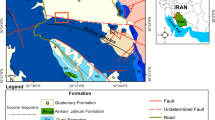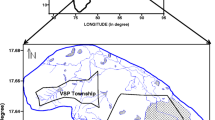Abstract
Ground-penetrating radar (GPR) techniques have been progressively developed to investigate several types of subsurface sedimentary features particularly in the upper zone of carbonate rocks. Most of common subsurface sedimentary heterogeneities such as karst in the western carbonate plateau of Assiut were formed by natural processes. Detection of the karst is very important to face up the expected socio-economical pressure, resulting from the dense population around the Nile Valley and important for the cement industry. These heterogeneities represent anomalies or departures from the surrounding or “background” geologic conditions which make them easier to detect by GPR. All the GPR profiles are made using an antenna 200 MHz. The 400 MHz antenna is used only to get more details on one of the detected abnormal zones. A series of the 3D model cross-section with variable depths in addition to 3D modules for the karst is constructed to ascertain the existence and the characteristics of these features. The careful analysis of the upper part of constructed GPR cross-section in the area is implemented by a digital three-dimensional model. It is believed that the examined area which having low-contrast variable-depth heterogeneities (karst features) may give a satisfactory outcome only by 3D simulation. This study indicates significant potential for the presence of karst in different locations and depths.
Similar content being viewed by others
References
Annan AP, Cosway SW, Redman JD (1991) Water table detection with ground penetrating radar. In: 61st Annual International Meeting, expanded abstracts: 494
Bakalowicz M (2005) Epikarst. In: Culver D, White W (eds) Encyclopedia of caves. Elsevier, Burlington, pp 220–223
Balkaya Ç, Göktürkler G, Erhan Z, Levent-Ekinci Y (2012) Exploration for a cave by magnetic and electrical resistivity surveys: Ayvacık Sinkhole example, Bozdağ, İzmir (W. Turkey). Geophysics 77(3):B135–B146
Carbonel D, Rodríguez V, Gutiérrez F (2014) Evaluation of trenching, ground penetrating radar (GPR) and electrical resistivity tomography (ERT) for sinkhole characterization. Earth Surf Proc Land 39(2):214–227
Carrozzo MT, Leucci G, Negri S, Margiotta S, Mazzone F (2008) Integrated geophysical and geological investigations for rock mass characterization in karst risk areas. Ann Geophys 51(1):191–202
Center for South Valley Development (CSVD) (2007) Georadar investigations in Egypt (internal report):60, Center of South Valley Devolpment in Assiut University
Collins ME, Cum M, Hanninen P (1994) Using ground-penetrating radar to investigate a subsurface karst landscape in North-Central Florida. Geoderma 61:1–15
CONCO (1987) Geologic map of Egypt. Egyptian General Authority for Petroleum (UNESCO Joint Map Project), 20 Sheets, Scale 1:500 000. Cairo.
Conyers LB (2016) Ground penetrating radar for geoarchaeology. Wiley, Hoboken, p 147
GSSI (1995) Operation manual of the RADAN-6 software. Geophysical Survey System, North Salem
Halliday W (2003) Caves and karsts of northeast Africa. Int J Speleol 32(1/4):19–32
Hantz D, Vengeon JM, Dussauge-Peisser C (2003) An historical, geomechanical and probabilistic approach to rock-fall hazard assessment. Nat Hazards Earth Syst Sci 3:693–701
Imposa S, Grassi S, Patti G, Boso D (2018) New data on buried archaeological ruins in Messina area (Sicily-Italy) from a ground penetrating radar survey. J Archaeol Sci Rep 17:358–365
Kareim MS (2001) Geomorphology of the east side of the River Nile. Sohag Bull Geog Soc Egypt 37:295–358
Kaufmann G, Romanov D (2009) Geophysical investigation of a sinkhole in the northern Harz foreland (North Germany). Environ Geol 58:401–405. https://doi.org/10.1007/s00254-008-1598-0
Kruse S, Grasmuech M, Weiss M, Viggiano D (2006) Sinkhole structure imaging in covered Karst terrain. Geophys Res Lett 33(16):L16405. https://doi.org/10.1029/2006GL026975
Leucci G, De Giorgi L (2010) Microgravimetric and ground penetrating radar geophysical methods to map the shallow karstic cavities network in a coastal area (Marina di Capilungo, Lecce—Italy). Explor Geophys 41:178–188
Meier E, Huggenberger P, Stiefelhagen W, Muller I, Christe R (1997) Geophysical methods as a tool for speleological and geotechnical investigation in karst Maira, Plateau de Bure JU, Switzerland. In: Proceedings of the 12th International Congress of Speleology, Switzerland, 2, pp 221–224
Miller RD, Steeples DW (1991) Detecting voids in a 0.6 m coal seam, 7 m deep, using seismic reflection. Geoexploration 28(2):109–119
Mostafa A (2013) Paleokarst shafts in the western desert of Egypt: a unique land scape. Acta Carsol Postojna 42(1):49–60
Nouioua I, Rouabhia A, Fehdi C (2013) The application of GPR and electrical resistivity tomography as useful tools in detection of sinkholes in the Cheria Basin (northeast of Algeria). Environ Earth Sci 68(6):1661–1672
Peterson CD, Doliber SR (2019) Groundwater surface (GWS) mapping by ground penetrating radar (GPR) for use in protecting freshwater habitats, water quality, and active dune landscapes, in the florence coastal dune sheet, Oregon, USA. J Geogr Geol 11(1):13–14
Pueyo-Anchuela O, PocoivJuan A, Soriano MA, Casap-Sainz AM (2009) A Characterization of karst hazards from the perspective of the doline triangle using GPR—Examples from Central Ebro Basin (Spain). Eng Geol 108:225–236
Redhaounia B, Ilondo BO, Gabtni H, Sami K, Bédir M (2016) Electrical resistivity tomography (ERT) applied to karst carbonate aquifers: case study from Amdoun, northwestern Tunisia. Pure Appl Geophys 173(4):1289–1303
Said R (1981) The geological evolution of the River Nile. Springer Verlag, New York, p 151
Said R (1990) The geology of Egypt. A. A. Balkema, Rotterdam-Brookfield, p 734
Sweeting M (1972) Karst landforms. Macmillan, London, p 362
Xie P, Wen H, Fu J, Li R (2018a) A methodology for three dimensional modeling of subsurface geologic structure in mantled karst area. J Comput Methods Sci Eng 18(3):667–682
Xie P, Wen H, Xiao P, Zhang Y (2018b) Evaluation of ground-penetrating radar (GPR) and geology survey for slope stability study in mantled karst region. Environ Earth Sci 77:122
Xie P, Wen H, Zhang Y, Zhang X, Hu J (2018c) A method for identification and reconstruction of hard structural planes, weak interlayer and cavities in the limestone near surface. Eur J Environ Civil Eng. https://doi.org/10.1080/19648189.2018.1512902
Xu XL, Peng SP, Xia YH, Ji WJ (2014) The development of a multichannel GPR system for roadbed damage detection. Micro-Electron J 45:1542–1555
Youssef AM, Al-Harbi HM, Gutiérrez F, Zabramwi YA, Bulkhi AB, Zahrani SA, Bahamil AM, Zahrani AJ, Otaibi ZA, El-Haddad BA (2016) Natural and human-induced sinkhole hazards in Saudi Arabia: distribution, investigation, causes and impacts. Hydrogeol J 24(3):625644. https://doi.org/10.1007/s10040-015-1336-0
Zajc M, Pogacnik Z, Gosar A (2014) Ground penetrating radar and structural geological mapping investigation of karst and tectonic features in flyschoid rocks as geological hazard for exploitation. Int J Rock Mech Min Sci 67:78–87
Acknowledgements
We would like to thank Prof. Dr. Hassan A. Soliman, Professor of Geology—Assiut University (Director of Center for South Valley Development) for his great efforts and facilities.
Author information
Authors and Affiliations
Corresponding author
Additional information
Publisher's Note
Springer Nature remains neutral with regard to jurisdictional claims in published maps and institutional affiliations.
Rights and permissions
About this article
Cite this article
Ebraheem, M.O., Ibrahim, H.A. Detection of karst features using ground-penetrating radar: a case study from the western limestone plateau, Assiut, Egypt. Environ Earth Sci 78, 563 (2019). https://doi.org/10.1007/s12665-019-8572-x
Received:
Accepted:
Published:
DOI: https://doi.org/10.1007/s12665-019-8572-x












